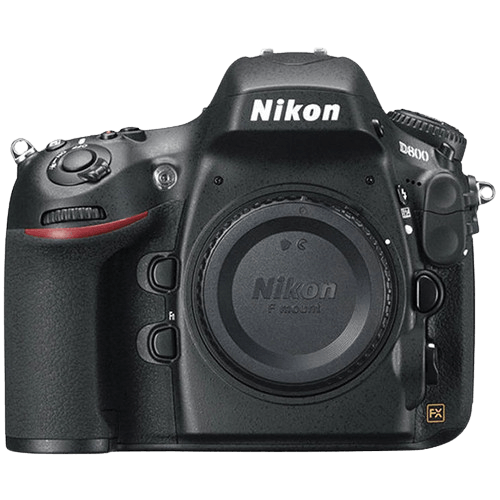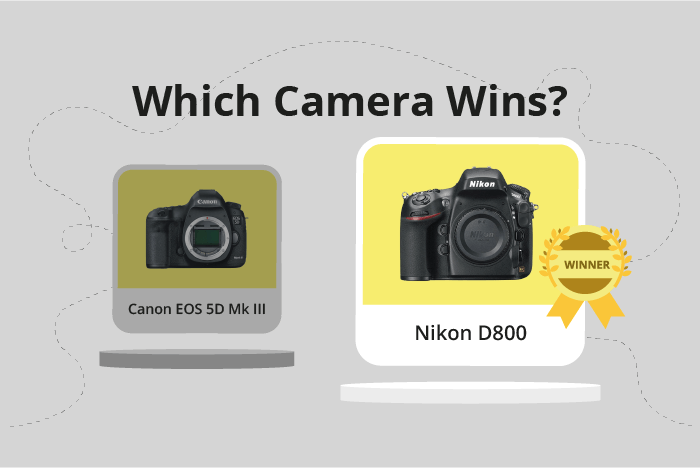Canon EOS 5D Mark III vs Nikon D800 Comparison
Canon EOS 5D Mark III

Nikon D800

The Nikon D800 edges out the Canon EOS 5D Mark III with a score of 69/100 compared to 65/100. Both cameras are DSLRs, released in 2012, and have similar dimensions and weight. The Canon 5D Mark III is slightly lighter at 950g, while the Nikon D800 weighs 1000g.
The Nikon D800 is superior in terms of launch price, costing $2999 compared to the Canon’s $3499. This makes it a more affordable option with a higher score. On the other hand, the Canon EOS 5D Mark III is better in terms of size and weight, making it more portable and easier to handle.
Taking these factors into account, the Nikon D800 offers better value for money with its lower price and higher score, while the Canon EOS 5D Mark III provides the advantage of a lighter and more compact body.
Canon EOS 5D Mark III vs Nikon D800 Overview and Optics
The Nikon D800 outperforms the Canon EOS 5D Mark III in optics with a score of 74/100, compared to the Canon’s 67/100. Both cameras share some similar specifications, such as the CMOS sensor type, full-frame sensor size, and the absence of image stabilization. They also have their respective lens mounts – the Canon EF for the EOS 5D Mark III and the Nikon F FX for the D800.
The D800’s higher score is primarily due to its superior 36.3-megapixel resolution, compared to the 5D Mark III’s 22.3 megapixels. This difference in resolution allows the D800 to capture more detail and produce larger prints. Additionally, the Nikon D800 boasts a higher DXOMARK sensor score of 95, while the Canon EOS 5D Mark III scores 81. This indicates that the D800’s sensor performs better in terms of color depth, dynamic range, and low-light capabilities.
However, the Canon EOS 5D Mark III has its advantages as well. The camera has a faster shooting speed of 6 frames per second, compared to the D800’s 4 frames per second. This makes the 5D Mark III more suitable for capturing fast-moving subjects, such as sports and wildlife photography. Furthermore, the Canon EOS 5D Mark III is equipped with a more advanced Digic 5+ processor, which contributes to faster image processing and better overall performance.
To conclude, the Nikon D800 excels in resolution and sensor performance, making it ideal for photographers who prioritize image quality and detail. On the other hand, the Canon EOS 5D Mark III is a better choice for those who require faster shooting speeds and better performance in fast-paced situations. Both cameras offer solid optics, but the choice depends on the specific needs and preferences of the photographer.
Canon EOS 5D Mark III vs Nikon D800 Video Performance
The Nikon D800 wins the video capabilities comparison with a score of 57/100, while the Canon EOS 5D Mark III scores 56/100. Both cameras share the same maximum video resolution of Full HD and video dimensions of 1920 x 1080. However, they differ in their maximum video frame rate and time-lapse functionality.
The Nikon D800 has a clear advantage in time-lapse functionality, as it is built into the camera. This feature allows users to create stunning time-lapse videos without needing additional software or equipment. On the other hand, the Canon EOS 5D Mark III does not have built-in time-lapse functionality, which may be a disadvantage for those looking to create time-lapse videos.
The Canon EOS 5D Mark III, however, does have a higher maximum video frame rate of 60fps, compared to the Nikon D800’s 30fps. This means that the Canon EOS 5D Mark III can capture smoother video, particularly in fast-moving scenes or when slow-motion effects are desired. The Nikon D800’s lower frame rate may result in less smooth video in certain situations.
In conclusion, the Nikon D800 has an edge in video capabilities due to its built-in time-lapse functionality. However, the Canon EOS 5D Mark III’s higher maximum video frame rate provides smoother video capture, making it a strong contender as well. Ultimately, the choice between these two cameras will depend on the individual user’s priorities and preferences in video features.
Canon EOS 5D Mark III vs Nikon D800 Features and Benefits
The Canon EOS 5D Mark III wins in the features comparison with a score of 59/100, while the Nikon D800 scores slightly lower at 57/100. Both cameras share several specifications, making them comparable in many aspects. They both have a 3.2-inch screen, lack a touchscreen, flip screen, GPS, and Bluetooth.
The Canon EOS 5D Mark III outperforms the Nikon D800 in screen resolution, providing 1,040,000 dots compared to the Nikon’s 921,000 dots. This higher resolution offers a clearer and sharper display for reviewing images and navigating the camera’s menu. The 5D Mark III’s higher feature score reflects this advantage over the Nikon D800.
On the other hand, the Nikon D800 boasts a feature that the Canon EOS 5D Mark III lacks: WiFi connectivity. This allows users to transfer images wirelessly and control the camera remotely, adding convenience and flexibility to the shooting experience. Despite its slightly lower feature score, the Nikon D800’s WiFi capability makes it a strong contender.
In comparing the Canon EOS 5D Mark III and Nikon D800, each camera has its strengths. The 5D Mark III’s higher screen resolution provides a better viewing experience, while the D800’s WiFi connectivity offers additional convenience. Ultimately, the choice between these cameras depends on the individual photographer’s priorities and preferences.
Canon EOS 5D Mark III vs Nikon D800 Storage and Battery
The Canon EOS 5D Mark III outperforms the Nikon D800 in storage and battery with a score of 76/100 compared to 71/100. Both cameras have two memory card slots and accept SD/SDHC/SDXC and Compact Flash cards. Neither camera offers USB charging.
The 5D Mark III has a longer battery life of 950 shots, using the LP-E6 battery type, which surpasses the D800’s 900 shots with its EN-EL15 battery. This advantage allows Canon users to capture more images before needing to replace the battery.
Despite its lower score, the Nikon D800 has the edge in memory card compatibility, as it supports UHS-I compatible SD cards, enabling faster data transfer rates. This can be beneficial for photographers who require quick data transfer for their workflow.
In terms of storage and battery, the Canon EOS 5D Mark III proves to be the better choice due to its longer battery life. However, the Nikon D800’s compatibility with UHS-I SD cards may appeal to some users who prioritize data transfer speed.
Canon EOS 5D Mark III vs Nikon D800 – Our Verdict
Are you still undecided about which camera is right for you? Have a look at these popular comparisons that feature the Canon EOS 5D Mark III or the Nikon D800:

